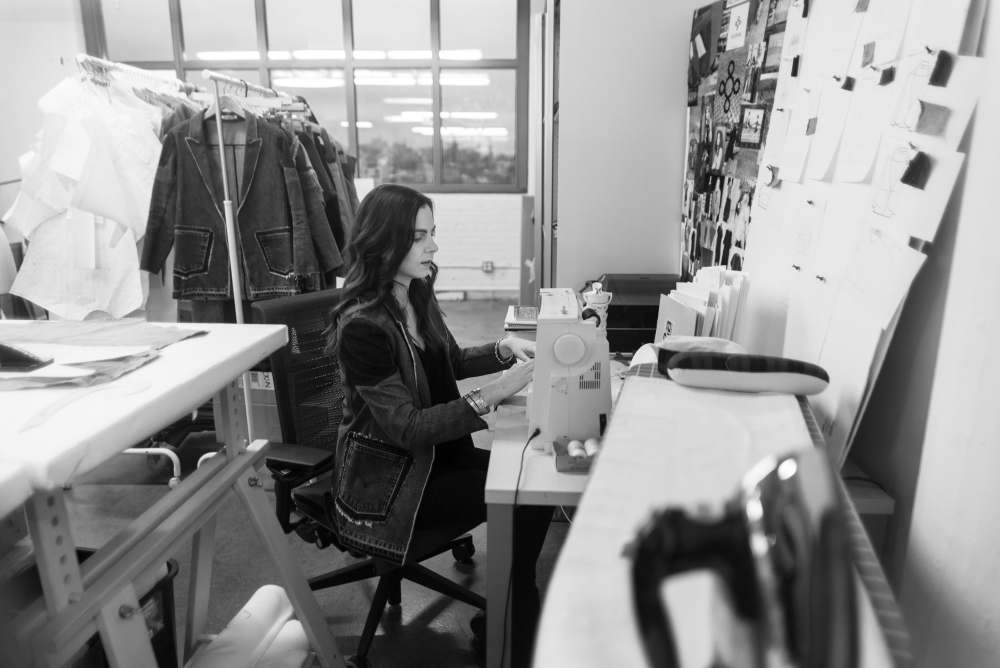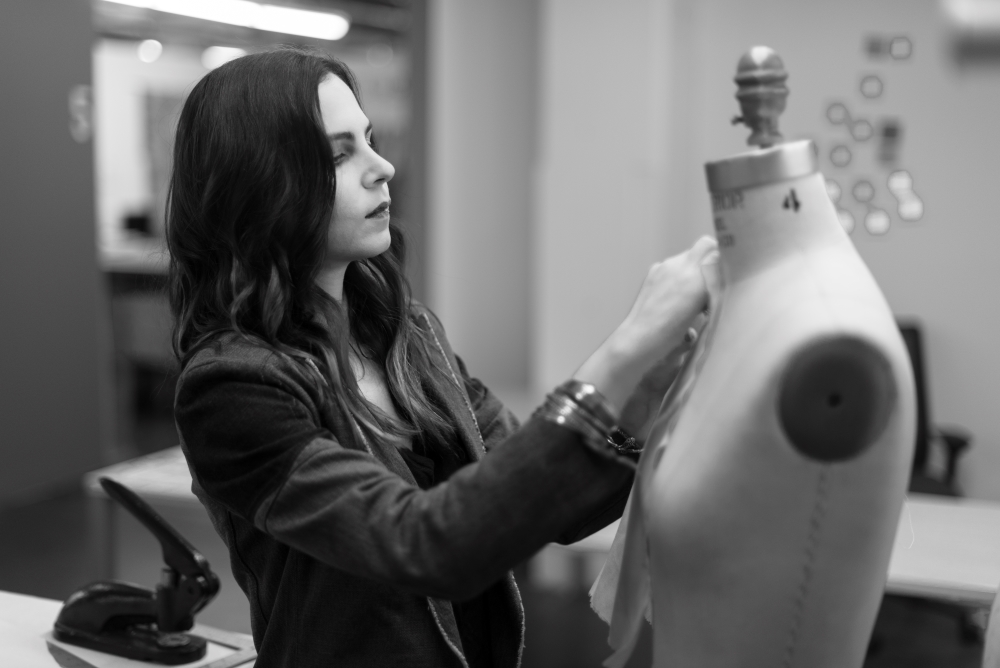
Interpreting the world
A conversation with sustainable fashion designer Noor Bchara
17/12/2019
Sustainability has never been synonymous with luxury. But what was only a niche concern and a noble pursuit a few years ago has now become one of the most pressing issues within the fashion industry. By taking a note from the OG of sustainable design – Stella Mccartney, the most influential fashion houses and designers are joining forces to collectively correct this faux pas by banning animal leather, furs and now turning to environmentally-friendly(‑ish) alternatives. And you know when the cool kids start to care about the climate crisis, it's only a matter of time before the rest follow suit.
For those who aren’t exactly versed in what that entails, there are many ways on how fashion designers can contribute to minimalizing their environmental footprint – recycling, using deadstock or sustainable fabric, and repurposing garments. Reuse of already made items is, of course, the most preferable option of the aforementioned, which is exactly what New York-based designer Noor Bchara has been doing with her brand Noorism for almost five years now.
The American sustainable fashion designer has built a brand on repurposing post-consumer denim jeans and is currently educating the new-gen fashion designers on upcycled and repurposed design at her alma mater – the Fashion Institute of Technology in New York. We met in Riga, where, through the Arts Envoy Program in partnership with the US embassy, Noor Bchara has flown in to give an introduction of the same lecture to Latvian ethical design enthusiasts at the Art Academy of Latvia.

Noor Bchara
You’ve worked at big fashion houses such as Zac Posen and Marc Jacobs. What was your initial impulse behind starting Noorism?
Previously I had sworn off the fashion industry, saying that I will never work in it again. I felt like I was a part of a system that was making things that were not well made, worn once and then put in a landfill. It didn't feel satisfying, rather pretty empty and shallow, so I left the industry. Afterward, I spent three years trying to reinvent myself, looking for a different career and came full circle because I already had the skills to work in fashion. I enjoyed it, so I decided to come back to it in a better way and make a positive impact.
I started Noorism in 2015 with an idea that I wanted to do sustainable fashion. I researched sustainability to figure out what kind of fabrics were sustainable and what wasn’t and came to the conclusion that it’s not a black and white answer.
It's also really expensive for a small designer to get sustainable fabrics, and it was even harder in 2015. If you find something you like, you’d have to buy the whole roll of fabric, which isn’t cheap. It’s a lot of money and risk upfront. At that moment, I decided to do denim upcycling, which would be even more of an interesting challenge and the product would be sustainable and different from everyone else’s.
Where did you begin when you decided to start your own sustainable fashion brand?
I started by going to Goodwill – a second-hand charity shop in the US – and buying jeans to make a couple of samples. At first, I made hats instead of clothing because it's ‘one size fits all’ and not having to do sizes makes the production process easier. They sell for a little bit less money and were easier to get into stores in the beginning.
But to be honest, I didn't know what I was doing. I had worked in fashion before that but I had never owned a company, so not making things too complicated or expensive helped in the process.
The high prices of sustainable fabric are the main reason why designers who are just starting can’t afford to go ‘green’. Buying environmentally friendly alternatives still seems like more of a privilege.
There are a lot more options than four years ago and the supply is continuing to grow. Now a lot of the fabric mills offer sustainable lines and they are more competitive in price than they used to be. There are even a few mills that offer recycled fabrics, which is another great option for people who want to work sustainably.
Making high-quality garments that are well made, timeless and meant to last in your closet is also a form of sustainable fashion. You know, designing things to be kept for the long term.
Is Noorism meant as a way of life?
When I came up with my concept, it was a play off my name. I wanted the concept to be about making a positive impact and doing better by upcycling. I had tons of grand ideas but I had to be practical and focus. In the beginning, I didn't know what I was going to do specifically; I just started with the name and the logo which was kind of a landing page.
Why did you choose to reuse denim in particular?
It wasn’t really on purpose. I started with denim because at the time it was easier to get my hands on it. It's timeless, always trendy, and it was really trendy in 2015. Once I made a few pieces in denim, it became really clear for me to focus on this one fabric so it’s more understandable what my brand is all about. I knew it would be easier to sell and it would keep my resources to a minimum. I’m small, so it’s really important to stay focused.
And it’s more cost-efficient.
And it’s cost-efficient. I only have to source one kind of fabric that I am constantly using. I don’t have to source new fabrics and colors every season.
How did you manage to get your hands on such a large quantity of jeans?
In the United States, more than 50% of the clothing donated to charity organizations such as Goodwill doesn’t get consumed and doesn’t go on sale in the charity shops themselves. There’s just too much, so it is sent to these big warehouses where it gets sorted and sent to developing countries. I go to these ‘rag houses’ and buy them by the piece before they’re shipped out.

Noorism Spring/Summer 2018
Does everyone have access to these warehouses?
No, you have to have a business and a tax ID number for it. Also, there’s a minimum, same as buying wholesale, and you have to spend a certain amount of money.
Doesn’t it get dull working with one material?
I’ve definitely gotten bored of denim (laughs). One season I experimented with overdying because I got sick of everything being blue. It’s also hard to make the collection look new every season if it’s always the same color. So I dyed some of my pieces black and charcoal, which was a lot of fun but adds to the cost. The black pieces even looked so good and brand new that some of the customers didn’t understand how much of a process went it to it to justify the price.
I bet that production from already finished garments is quite challenging. How many jeans does it take to make a new garment?
It takes about two pairs of jeans to make a jacket. And I figured out that instead of taking them apart and giving them to the factory as fabric, I can just count the necessary amount for production and give the jeans to the factory as is. I usually give extra, because it doesn’t always work out exactly as you plan. Sometimes jeans have stains on them or we run into other issues.
What are the most important steps for producing a repurposed garment?
The most important part of the process is sourcing and finding jeans that are the right fabric, color, and consistency I’m looking for. I like denim without the stretch – old Levi’s and Wrangler’s are my favorite ones. It’s not as easy as ordering a roll of fabric that gets shipped straight to the factory. You have to physically go there and select the fabric one by one before it goes through another facility to get washed.
Manufacturing is even more challenging because we are using individual pairs of jeans, and finding a factory that’s willing to work this way wasn’t easy. When the factory is doing a production, normally they stack 50-100 layers of fabric and with a rotary cutting machine cut them all at once, to make the cutting process much more efficient and faster. But for my garments, the cutting process is similar to that of cutting leather because each pair of jeans is a different size, shape, and style. They cannot be stacked! And I also prefer to see the shading when you deconstruct the jeans, so I can figure out the placement and where it’s necessary to add seams that would look cute on the finished garment. All the labor involved in washing, ripping them apart, deconstructing, sewing into new pieces and finishing raw edges so they don’t unravel... it’s a lot!
So you’re overseeing every step of the creation process.
I find that being involved in making the samples helps me with the design process. Once I have the sample, I can send it to the factory and they can copy it.
There are not many sustainable brands that reuse fabrics to create new pieces, which makes your label stand out. Is that because of the stigma around the idea of purchasing a repurposed garment that is made of used or unwanted clothing?
It’s perhaps not meant for everybody, and that’s why I am really careful about the way I talk about the brand and the words that I use. When I started, and I think it’s changing a little bit now, I found out that I don’t like to use the word ‘upcycled’ to describe it – more like ‘creative reuse’, ‘repurposed’ and other words that sound more elevated, because I don’t want to be perceived as a DIY, homemade or Etsy. I worked very hard to design pieces that don’t resemble that and I make sure that that is reflected in the photography. And because I’m using such a great common fabric, you can see the beautiful discoloration of where the seams used to be. This adds something special to the pieces and they don’t just look like somebody's leftover, discarded junk.
Duly noted. This association with the term probably didn’t cross my mind because it’s not that common in our circles to indulge in Etsy’s latest DIY projects.
I still whisk myself into the category of upcycled, and I would definitely have the word upcycled as one of the keywords on my website, but I just wouldn’t use it for branding or marketing.

You’ve been in Latvia just for a few days now, but have you ever noticed any differences in attitude between America and Europe towards the integration process of sustainable alternatives in fashion?
Well, from what I understand, I’ve been told that there’s a little bit of pushback towards upcycling just because it’s so much in the culture here. It’s been done out of necessity for so long and it’s a tough sell to get people to want to pay money for something that’s upcycled when that’s basically what they’ve been doing – saving clothes, fixing them or taking them to get refitted. But I also think that because it’s so much in the culture here, it’s also a perfect place to do more of it and to specialize in it. Maybe it’s more about creating upcycled pieces here to sell to other places.
From what I can see, the ‘common’ factor is the main reason why shiny new fabrics will have an upper hand here. It seems relatively impossible to be an environmentally friendly but also creative and innovative force in the industry. Is it even possible to have the one not impact the other?
Definitely; being sustainable forces me to be more creative because creativity comes from constraints and a set of rules. For me, using only denim and post-consumer jeans forces me to find ways of being creative within that. You can be more creative that way. And you know, when you limit yourself to whatever fabric you can think of to upcycle, or certain fabrics that are sustainable, you can come up with a lot of your own ideas and figure out ways to use those fabrics differently.
Do you think that the high-fashion brand attempts to be sustainable will have an impact?
I think that high-fashion already is sustainable because it’s well made and has high-quality craftsmanship. It’s not meant to be consumed and thrown away; it’s meant to last. Fast fashion is the real problem. They make everything very cheaply in huge quantities for the mass consumer and are designed to be worn once and discarded. I think high-fashion can improve by using more sustainable materials, but at least they are still using quality craftsmanship.
Where luxury labels lead, fast fashion usually follows. Recently, 32 companies, including Zara and H&M, signed the Fashion Pact – an agreement to emphasize sustainability in the industry. Although promising on paper, fashion brands still put out four collections per year. Doesn’t that seem like a double standard given that the issue is the excessive production of garments?
Yeah, the fashion system is definitely about consuming and keeping things new, but there are a lot of designers now that are going against that old business model by not releasing a collection each season, and produce only when they feel like they should or release one piece at a time. And going back to before – high-end designers put out a new collection each season, but the fast-fashion companies do that every week. They are constantly creating more stuff that is thrown into the marketplace. I do agree that it is kind of like a contradiction, but fashion is also about change and interpreting the world. Fashion is about interpreting all that’s going on socially, politically and all the other aspects. Some parts of those aspects do have to keep producing at some level, even if it’s for art. I mean, it is a business you still have to sustain it by producing something your customer wants. You can’t just stop producing or you just won’t be able to do anything positive either. So it’s a balance.
In 2017 Burberry burned 37 million dollars of unsold items, which is one of the most shocking business moves reported in the last few years.
That is terrible, and there can be a lot of improvements in the high fashion side of the industry as well. It would be really helpful if the brands got over the idea that if something comes out a little bit wrong or unexpected, then just because it has their label on it, it has to be destroyed. I can understand why they are doing it but there can be other solutions; it doesn’t have to be that way. That most certainly has to change. From my experience of living in Brooklyn, there is this store, which I’m not going to name, that puts on the street bags of brand-new jeans – but slashed, so no one could wear them again. They didn’t even take their labels off, just cut them so that they were unwearable and put them in the trash. Bags of them.
...when they could be easily repurposed in-house.
Yes – when they can be donated, recycled or repurposed. Companies should be responsible for what happens to the garments that they make and where they end up, absolutely.
What alternatives do these companies have to deal with this issue? What is the optional short-term solution?
The customer has a lot of power, especially when people are more aware and demanding from the companies they buy from. Customers demanding more transparency will be a big, prominent change, and it would be really helpful if the government stepped in to pass a law that forbids throwing away your cutting-room scraps. They should be recycled the same as paper and plastic. So, it should come from both sides.

Noorism Spring/Summer 2018
It’s similar to the French law that forbids food waste and bans supermarkets from throwing away or destroying unsold food – they must instead donate it to charities. This should apply to fashion as well.
Exactly. And it does cost the company a lot of money to recycle or donate those scraps, but it should be a requirement for all industries – to do that and to be responsible for whatever the byproduct is of what they’re producing.
As consumers, what are our options? What’s the best thing we can do to lower our environmental footprint when it comes to apparel?
We can shop less, keep the clothes longer, and buy things that are ethically made. We should look into where the garment was made, what the materials are, and make sure that we know about the brand and designer that’s producing it. We can also buy secondhand clothing or go to clothing swaps.
Thrift shopping has definitely become a worldwide trend with a positive impact thanks to the upsurge of the celebrity-supported Depop and vintage stores that sell a lot of iconic luxury brand pieces. It goes to show that thrift shopping can be for everyone.
Definitely! Also, in the US there’s a company called Rent the Runway where you can just rent high-end designer pieces. By paying a monthly fee, which is not nearly as much as buying these clothes, you get to rent clothing that would normally sell for thousands of dollars. Just borrow it, wear it and give it back! This way, fashion is more democratic.
High-end items are not meant for everyday wear anyway.
For a person who would normally buy fast fashion, but wants to keep up with trends and be fashionable, it’s an option to rent the ‘real fashion’. This company is buying a few pieces of high-end garments and putting them into rotation by constantly sending them out to people to wear. So fewer of them have to exist in the first place.
Do you believe that there is the slightest possibility that we would ever see the end of fast fashion all together? What do you think it takes to collectively get to that point?
Fast fashion is going to change only with the consumer. I think that if people are willing to buy it, then it’s going to keep existing. But on a larger scale, it’s positive that large companies like H&M are making changes towards sustainability and educating the customer. Because a small change from a company like that can make a really big impact.
Educating the younger generation to shop vintage and to remake their clothes (instead of buying fast fashion) is the only way to decrease the amount of fast fashion that is consumed.
If people want it less, there will be less of it existing.
What do you think could be done more in terms of sustainability within the industry?
I wish that sustainable fabrics would be the only kind available and that a lot more companies would upcycle by collecting back their clothing and remaking it themselves. I’d like to point out one company in New York that is doing exactly that – Eileen Fisher; but a lot more brands could be as well. I would like to see larger brands take more responsibility for unneeded garments that they’ve produced and the leftover cutting-room scraps and all other byproducts of their manufacturing process.
Where can we find the best inspiration for sustainable fashion?
I get inspired by the places that I’ve traveled to and the things that I’ve seen there. For instance, I went to Cuba this year, which is big on upcycling as well. I found all kinds of interesting jewelry and got a lot of ideas that I can use for my brand going forward.
And art in general. I like the Dada movement because it’s kind of about upcycling and questioning what art is. For example, Marcel Duchamp’s Fountain.

What can we expect from you next?
I’ve ended up with a lot of zippers that I don’t know what I want to do with, but I found some ideas in Cuba on how to integrate these cutting-room scraps into finished garments.
Do you have any advice to designers who are taking steps to become more ethical and sustainable?
Start small and stay focused. Focus on one or two things that you can do well, and use whatever resources you have. If you don’t have a lot of money, then use your time and connections to figure out who can help you. Just don’t give up!
The interview was conducted with the help of cooperating partners Investment and Development Agency of Latvia and Arts Academy of Latvia.